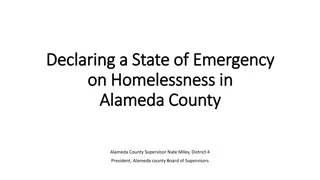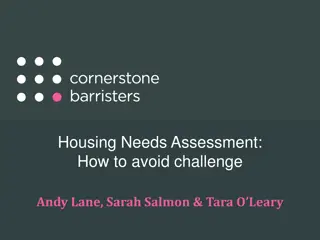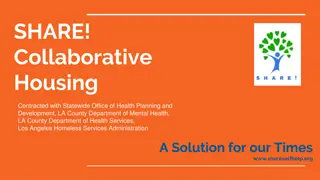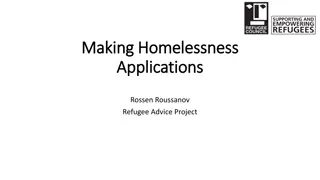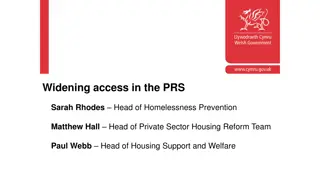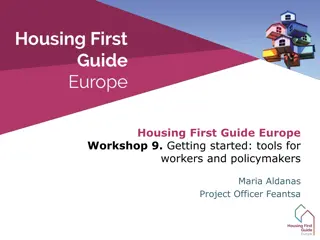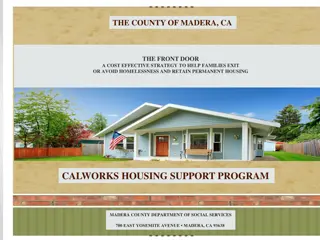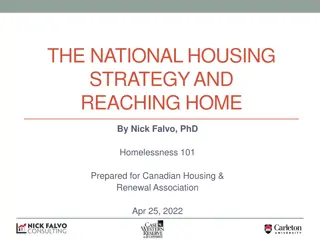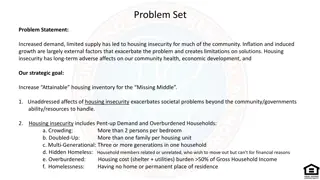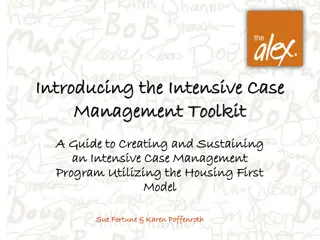Understanding Housing First Approach in Homelessness Solutions
Housing First is a targeted service for homeless individuals with high and complex needs, aiming to provide them with permanent and transitional housing along with ongoing, flexible support services. Unlike traditional models, Housing First places individuals directly into their own homes with mobile support services, promoting independence and stability. This approach has gained popularity globally, with countries like France, Italy, Finland, and the USA incorporating it into their national strategies to address homelessness effectively.
Download Presentation

Please find below an Image/Link to download the presentation.
The content on the website is provided AS IS for your information and personal use only. It may not be sold, licensed, or shared on other websites without obtaining consent from the author. Download presentation by click this link. If you encounter any issues during the download, it is possible that the publisher has removed the file from their server.
E N D
Presentation Transcript
Housing First Nicholas Pleace
Contents What is Housing First? Why is everyone using it? Key principles Adapting Housing First to the UK context Related models Critical Time Intervention (CTI) Housing-led services
What is Housing First? Targeted service Homeless people with high and complex needs Severe mental illness Drugs and alcohol Entrenched rough sleepers NOT NOT for anyone else
What is Housing First? Treatment First/ Staircase Model Permanent Permanent housing housing Transitional Transitional housing housing Level of independence Level of independence Underlying theory and values: Underlying theory and values: Transitional placements provide for stabilization and learning. Individual change is required through treatment. Consumers must earn permanent housing Shelter Shelter placement placement Homeless Homeless Treatment compliance + psychiatric stability + abstinence Treatment compliance + psychiatric stability + abstinence
What is Housing First? Housing First Model Permanent Permanent housing housing Transitional Transitional housing housing Shelter Shelter placement placement Ongoing, flexible supports Ongoing, flexible supports Homeless Homeless
What is Housing First? In existing service responses, someone follows a pathway, staircase or treatment model that makes them housing ready Trained and supported to live independently after a stay in accommodation-based (single site) supported housing In Housing First, put straight into their own home with mobile support services
Why is everyone using Housing First? France Italy Belgium Finland Denmark Portugal Spain Ireland Netherlands Austria Canada USA Homeless Link FEANTSA
Housing First in National Strategies Canada Denmark Finland France USA
Housing First in England (UK) Original model built for New York in the early 1990s Access to emergency medical treatment No benefits for working age adults Private rented sector apartments (flats) Used leasing arrangements, tenancy held by service Exercised financial controls over service users
Housing First in England Housing First started to be looked at here and in Europe Could be seen it was not designed to work in contexts where there were benefits systems, universal healthcare, social housing Therefore a need to adapt Important to distinguish between core principles And operational flexibility
Adapting Housing First FEANTSA has produced the Housing First Guide Europe Which contains UK examples Homeless Link are working on a guide/fidelity list for UK homelessness service providers and commissioners
Basics of operation Ordinary housing Immediately or as soon as possible Usually scattered Own tenancy Support provided by mobile team, offering intensive case management (ICM) Some intensive services may have their own multidisciplinary team (ACT) but this does not appear to have happened in the UK
Core Principles Housing is a human right Choice and control for service users Separation of housing and treatment Recovery orientation Harm reduction Active engagement without coercion Person-centred planning Flexible support for as long as is required
Same as tenancy sustainment services No, it is not Case loads of between 3-10 per worker Support for as long as is needed Highly flexible as well as intensive Stays with the person if they are Evicted Imprisoned Hospitalised
Where will the housing come from? Overriding point here is that Housing First is only for homeless people with high and complex needs Not that there are not challenges in sourcing suitable housing But there are in practice very few people in this group at any one point in time This makes it viable, even in London
UK examples London has multiple services Also the Midlands North East Greater Manchester South Coast Wales Scotland Northern Ireland
Successes 83% housed @ 1 year (Portugal) 77% housed @ 5 years (Netherlands) 94% housed @ 1 year (Denmark) 80% housed @ 13 months (France) 74% housed @ 1 year (England) 74% housed @ 1 year (England) Typically performance is 8 out of every 10 Compared to evidence for this particular group of 30- 50% success rate for pathway/staircase services Evidence of ending very long-term homelessness in UK Camden Housing First Turning Point Glasgow
Cost effectiveness One year of Housing First costs about 9,000 in support costs Compared to 14,000 to 25,000 in support costs for one year in single-site, congregate, supported housing (hostel) for high need homeless people (purpose built, on-site staff) Save around 5- 16,000 using Housing First Only true if They are high need homeless people that would get stuck in supported housing Or make extensive use of other homelessness services
Housing First Best Thing Ever? No, of course not Very high rates of housing sustainment for homeless people with highest needs But it is not intended for other homeless people with lower support needs Some single homeless people Most homeless families Not an answer or a strategy in and of itself
Housing First in context Results are spectacular in terms of housing sustainment Less clear that Housing First produces consistent gains in health and well-being Same for drug and alcohol use And for community and social integration Expecting Housing First to be a panacea is illogical not a claim made by advocates of Housing First Reliant on other services Needs a housing supply and while not unfeasible, still a challenge Commissioner attitudes and resources Some UK Housing First pilots have had a funding sunset and closed
Related models Housing-led services Basically tenancy sustainment services or floating support as we would recognise it, but sharing elements of the Housing First philosophy Much less intensive, can be time-limited Critical Time Intervention (CTI) Slightly inaccurate to do so, but easiest describe as a time limited Housing First model that provides very similar support for up to nine months. The idea is to transition service users to lower intensity support services as they are ready to live more independently US evidence base is extensive and shows good results, also positive results from Denmark
More Information Housing First England http://www.homeless.org.uk/our-work/national- projects/housing-first-england Homeless Link Housing First Guide Europe http://housingfirstguide.eu/ FEANTSA Canadian Housing First Toolkit http://www.housingfirsttoolkit.ca/



